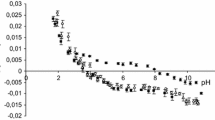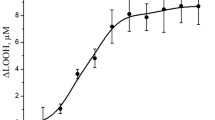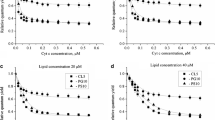Abstract
The complexes Al(acac)3 (1) (acac = 2,4-pentanedionate) and Al(malt)3 (malt = 3-hydroxy-2-methyl-4-pyronate) (2) react with dl-α-dipalmitoylphosphatidylcholine (DPPC) under a 1:1 molar ratio in CDCl3 at 37 °C, as shown by the substantial release of ligands (20–50%) from the metal coordination sphere (1H-NMR), by evident changes in the 1H-NMR spectrum of DPPC in the reaction mixture and by the appearance of a 31P-NMR signal due to metal-coordinated DPPC. 31P-NMR spectra reveal that both 1 and 2 also react with DPPC in water, in the presence of 1% Triton X-100 and Tris buffer. Under these conditions, 1 and 2 do not react with ghosts from human erythrocytes. On the contrary, the far less hydrolytically stable complex Al(lact)3 (lact = lactate) appears to be reactive under identical conditions, as shown by 31P-NMR spectra.
Similar content being viewed by others
References
Akitt JW. 1987 Aluminum, gallium, indium and thallium. In: Mason J, ed. Multinuclear NMR. New York: Plenum Press; 259–292.
Benn R, Rufinska A, Lehmkuhl H, Jannsen E, Kruger C. 1983 27Al-NMR spectroscopy; a probe for three-, four-, five- and sixfold coordinated Al atoms in organoalumium compounds. Angew Chem Int Ed Engl 22, 779–780.
Banks WA, Kastin A. 1989 Aluminum-induced neurotoxicity: alterations in membrane function at the blood-brain barrier. Neurosci Behav Rev 13 47–53.
Corain B, Perazzolo M, Fontana L, et al. 1991 The effect of aluminum (III) on the integrity of plasmatic membranes: relevance to Alzheimer's disease. In: Iqbal K, McLachlan DRC, Winblad B, Wisniewki H, eds. Alzheimer's Disease: Basic Mechanism, Diagnosis and Therapeutic Strategies. New York: Wiley & Sons; 394–398.
Corain B, Tapparo A, Sheik-Osman AA, Bombi GG, Favarato M, Zatta P. 1992a The solution state of aluminum (III) as relevant to experimental toxicology: recent data and new perspectives. Coord Chem Rev 112, 19–32.
Corain B, Longato B, Sheik-Osman AA, Bombi GG, Maccà C. 1992b Aluminum carboxylates in aqueous solutions. Part 2. Metal speciation in the AlIII-lactate-OH−*-H2O system. J Chem Soc Dalton Trans 169–172.
Deleers M, Servais J-P, Wuelfer E. 1985 Micromolar concentrations of Al3+ induce phase separation, aggregation and dye release in phosphatdylserine-containing lipid vesicles. Biochim Biophys Acta 813, 195–200.
Deleers M, Servais J-P, Wuelfer E. 1986 Neurotoxic cations induce membrane rigification and membrane fusion at micromolar concentrations. Biochim Biophys Acta 855, 271–276.
Ernst RR, Badenhausen G, Wokaun A. 1987 In: Bernstein RB, Breslow R, Green MLH, Halpern J, Rowlinson JS, eds. The International Series of Monographs on Chemistry. Principles of Nuclear Magnetic Resonance in One and Two Dimensions. Oxford: Clarendon Press.
Favarato M, Zatta P, Perazzolo M, Fontana L, Nicolini M. 1992 Aluminum (III) influences the permeability of the blood-brain barrier to (14C)sucrose in rats. Brain Res 569, 330–335.
Fendler JH. 1982 Membrane Mimetic Chemistry. New York: Wiley.
Finnegan MM, Rettig ST, Orvig C. 1986 A neutral water-soluble aluminum complex of neurological interest. J Am Chem Soc 108, 5033–5035.
Finnegan MM, Lutz TG, Nelson WO, Smith A, Orvig C. 1987 Neutral water-soluble post-transition-metal chelate complexes of medical interest: aluminum and gallium Tris(3-hydroxy-4-pyronates). Inorg Chem 26, 2171–2176.
Karlik SJ, Elgavish GA, Eichorn GL. 1983a Multinuclear NMR studies on Al(III) complexes of ATP and related compounds. J Am Chem Soc 105, 602–609.
Karlik SJ, Tarien E, Elgavish GA, Eichorn GL. 1983b Aluminum-27 nuclear magnetic resonance study of aluminum (III) interactions with carboxylate ligands. Inorg Chem 22, 525–529.
Nicolini M, Zatta P, Corain B, eds. 1991 Aluminum in Chemistry, Biology and Medicine, vol. 1. Verona: Cortina International-Raven Press.
Khachaturian ZS. 1986 Aluminum toxicity among other views in the etiology of Alzheimer's disease. Neurobiol Aging 7, 537–539.
Kruck TPA. 1993 Aluminum-Alzheimer's link? Nature 363, 119.
Laussac J-P, Commenges G. 1983 1H, 13C, 31P and 27Al NMR study of aluminum-ATP complexes. A possible relation with its biological application. Nouv J Chem 7, 579–585.
Panchalingam K, Sachedina S, Pettergrew JW, Glonek T. 1991 Al-ATP as an intracellular carrier of Al(III) ion. Int J Biochem 23, 1453–1469.
Perl D, Good PF. 1993 Aluminium in Alzheimer's? Nature 362, 418.
Pettegrew JW. 1986 Aluminum and Alzheimer's disease: an evolving understanding. Neurobiol Aging 7, 539–540.
Sovago I, Kiss T, Martin BR. 1990 2,3-Diphosphoglycerate binding of Zn2+ and Al3+. Polyhedron 9, 189–192.
Sturman JA, Wisniewski H. 1988 Aluminum. In: Bondy SC, Prasad KN, eds. Metal Neurotoxicity. Boca Raton, FL: CRC Press, 183–204.
Tapparo A, Perazzolo M. 1989 n-Octanol/water partition coefficients of the acetylacetonate and maltolate complexes of Al(III), Cr(III) and Fe(III) and of aluminum lactate. Int J Environ Anal Chem 36, 13–16.
Van Rensburg SJ, Carstens ME, Potocnik CV, Aucamp AK, Taljiaard JJF, Koch KR. 1992 Membrane fluidity of platelets and erythrocytes in patients with Alzheimer's disease and the effect of small amounts of aluminium on platelets and erythrocytes membranes. Neurochem Res 17, 825–829.
Vierstra R, Haug A. 1978 The effect of Al3+ on the physical properties of membrane lipids in thermoplasma acidophlilum. Biochem Biophys Res Commun 84, 138–143.
Zatta P, Perazzolo M, Bombi GG, Corain B, Nicolini M. 1989 The role of speciation in the effects of aluminium(III) on the stability of cell membranes and on the activity of selected enzymes. In: Iqbal K, Wisniewski HM, Winblad B, eds. Alzheimer's Disease and Related Disorders. New York: Alan R Liss; 1087–1094.
Zatta PF, Nicolini M, Corain B. 1992 Aluminium (III) in experimental cell pathology. In: Williams RJP, chairman. Aluminium in Biology and Medicine (Ciba Foundation Symposium 169) Chichester: John Wiley & Sons; 186.
Author information
Authors and Affiliations
Rights and permissions
About this article
Cite this article
Zambenedetti, P., Tisato, F., Corain, B. et al. Reactivity of Al(III) with membrane phospholipids: a NMR approach. Biometals 7, 244–252 (1994). https://doi.org/10.1007/BF00149555
Received:
Accepted:
Issue Date:
DOI: https://doi.org/10.1007/BF00149555




